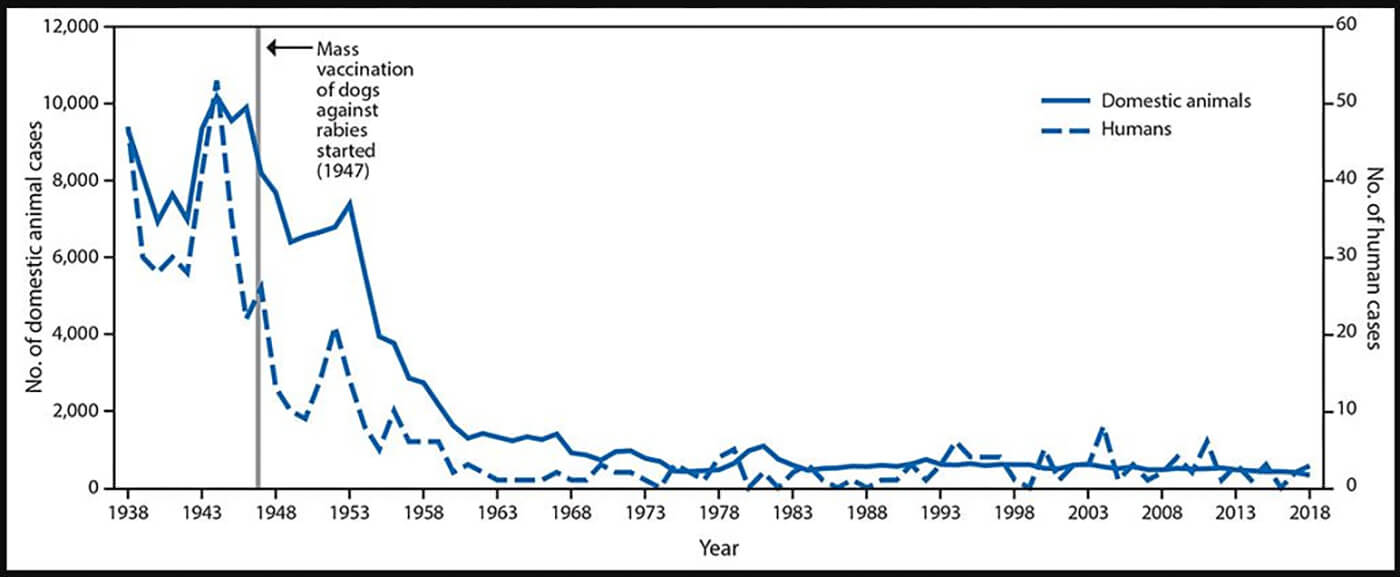October 15, 2025
In 300 BCE, the Greek philosopher Aristotle described dogs suffering from “a madness” and noted that other animals became similarly diseased if bitten by affected dogs. He was recounting rabies, an acute, progressive, ultimately fatal inflammation of the brain and spinal cord, and one of the oldest recognized zoonotic diseases. For thousands of years, rabies was one of the most dreaded illnesses because there was no way to prevent it, and no effective treatment. However, because of the development of effective vaccines and post exposure prophylactics (PEP), rabies is today almost a forgotten disease in the United States and Western Europe. Unfortunately, in Asia and Africa, where vaccinations are less prevalent, rabies kills nearly 60,000 people every year. The story of rabies is thus a powerful testament to the effectiveness of vaccines and an important demonstration of the ONE Health concept.
Rabies is caused by group of neurotropic viruses in the family Rhabdoviridae, genus Lyssavirus. Lyssavirus is derived from the name of a minor goddess in Greek mythology, Lyssa, the spirit of rage and fury. It is likely that Lyssaviruses originated in Old World bats native to the Eastern Hemisphere which are confirmed reservoir hosts for 14 of the 16 known Lyssavirus species. These viruses are now found in mammals throughout the world, except in Antarctica, and while all Lyssaviruses can cause encephalitis in mammals, the non-rabies Lyssaviruses have been implicated in only a handful of infections of humans.
Although a single virus (Lyssavirus rabies-RABV), the rabies virus has many variations with distinct geographical distributions and host ranges. Most commonly, the virus is divided into bat-related RABV, which circulates primarily in bats in the Americas, but which is also found in some terrestrial carnivores, such as skunks, raccoons and foxes, and dog-related RABV, which circulates in dogs and wild carnivores in the Old World (Africa, Asia, Europe and Australia) and parts of the New World (the Americas).
Rabies is typically transmitted by a bite or scratch from an infected animal. The incubation period, the time between exposure and the appearance of clinical signs, may last from weeks to months. The first symptoms are often flu-like, including weakness, fever, and headache. There also may be discomfort, a prickling, or itching sensation at the site of the bite or scratch. Usually, signs of severe disease, including anxiety, confusion, agitation, and hallucinations, appear within two weeks of the first symptoms. Hydrophobia, fear of water, is a common symptom. In the later stages of the disease, rabies causes paroxysmal contractions of pharynx leading to severe pain while swallowing any liquid. Thus, rabies sufferers don’t fear water so much as the pain of attempting to swallow it.
The lack of an effective prevention or treatment for rabies changed in 1885 when Emile Roux and Louis Pasteur developed a vaccine against Lyssavirus rabies-RABV. Although at the time it had only been tested in dogs, Pasteur and his colleagues were convinced to try the vaccine in a young boy who had been bitten 14 times by a rabid dog. The child received 12 doses of the vaccine over 10 days and miraculously survived. The development of the vaccine is even more amazing when one considers that at the time neither the structure nor properties of viruses were understood. In the 19th century, they were referred to as “filterable agents” because they were so small they could be isolated by passing fluids collected from an infected individual through diatomaceous earth filters. Larger pathogens, by contrast, such as bacteria and fungi, could not pass through the filters. In fact, viruses were not visualized at all until 1931, when the German engineers Ernst Ruska and Max Knoll used electron microscopy to generate the first images of the organisms.
Today, the risk of contracting rabies depends very much on where someone lives or travels. A number of countries are considered rabies free, including New Zealand, the United Kingdom, Japan, many Caribbean Island nations, and much of Western Europe. In other countries, including the U.S., rabies is considered controlled. Rabies still occurs in wildlife in these countries, but the incidence of infection in humans and domesticated animals is quite low. Dog-related RABV was eliminated in the U.S. in the 1970s, thus today only bat-related RABV is responsible for domestically acquired cases of the disease.
Mass vaccination of domesticated animals is one of the primary factors for controlling or eliminating rabies, as illustrated in the figure below depicting the decrease in cases of the disease in the United States after 1947.

Among humans in the U.S., just 17 cases of rabies were documented from 2015 to 2024, two of which were contracted outside of the country. However, while rabies has been well controlled, growing canine vaccination hesitancy among American pet owners could be changing that. According to NBC News, in August 2025, the Centers for Disease Control reported they were tracking 15 outbreaks of rabies in wildlife in the U.S., and that there had been six human deaths from rabies in the past 12 months, a significant increase over the past three years. If an unvaccinated dog or cat is exposed to a rabid animal, the CDC recommends either euthanasia or a 4-month quarantine period.
Recently, discussions about the benefits and risks of vaccinations have become politicized, instead of being based on science and data. There is no denying, however, that widespread vaccination of dogs and cats for rabies has dramatically decreased rabies deaths in pets and humans in the U.S. Keeping our pets fully vaccinated is critical to maintaining their health, and in the case of rabies, our own.
– Cindy Cole, DVM, PhD, DACVCP
First Five
First Five is our curated list of articles, studies, and publications for the month.
1/ Follow the Camels
Recently, scientists discovered monumental works of rock art on cliff faces in the desert of Saudi Arabia dating back over 10,000 years. Alongside numerous camels, there were other large mammals, including ibex, horses, gazelles and aurochs. The team also found engraved human figures and face masks. One 3-metre-tall dromedary was spotted more than 40 meters up a cliff face and could only be photographed by drone, leaving the scientists wondering how the ancient artist managed to carve it. The scientist hypothesized that the art could have been to direct other travelers to water sources or warn them that the area was already inhabited.
2/ Leash Etiquette
Many dogs pull on their leashes and if they pull hard enough on their collars they can damage their tracheas, which has led some owners to switch to harnesses. However, a recent study found that dogs pull even harder when wearing a harness compared to a collar. As a percentage of their body weight, small dogs actually pull harder than larger ones. Although the harness may be easier on the dog’s trachea, owners may end up in an even bigger tug of war. Training the dog to walk properly on a leash without pulling is likely the better option.
3/ And More News From the Desert
Cheetahs (Acinonyx jubatus) have experienced a steep population decline as a result of habitat loss, hunting and animal trade. They disappeared from the Arabian Peninsula decades ago. Recently, however, scientists reported finding seven mummified cheetahs and the skeletal remains of 54 others, some dating back thousands of years, during surveys in the Lauga cave network in northern Saudi Arabia. This is some of the first evidence that cheetahs were once prevalent in this part of the world.
4/ Which Cat Breeds Live the Longest?
A recent study analyzed the typical lifespan of cat breeds and found that Burmese and Birman had the longest life expectancy at 14.4 years, which was twice as long as the shortest lived breed, the Sphynx, at 6.7 years. Crossbreeds were also long-lived with a typical lifespan of 11.9 years. The study also found that other characteristics, such as being sexually intact, purebred, and having a non-ideal body weight, were significantly linked to a decrease in lifespan.
5/ Which Dog Breeds Live the Longest?
A recent study, which included data from 584,734 dogs belonging to 155 breeds, found that the average lifespan of dogs was 12.5 years. The size of the dog and the shape of their muzzle best predicted lifespan, with small, long-nosed dogs having the longest life expectancy, surviving 13.3 years on average, while medium-sized, flat-faced dogs had the worst outcomes, surviving on average nine years. One of the most surprising findings was that purebreds had a longer life expectancy than crossbreeds, 12.7 years compared with just 12 years respectively. In terms of specific breeds, the Lancaster Heeler was the longest lived at 15.4 years an average, while the breeds with the shortest average life span were the Presa Canario at 7.7 years and the Caucasian Shepard Dog at 7.4 years.
To subscribe to Engineering Biology by Jacob Oppenheim, and receive newly published articles via email, please enter your email address below.





